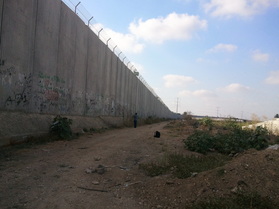 The wall through Qalquilya The wall through Qalquilya The first time I read Faulkner's As I Lay Dying I was fascinated by the fifteen or so perspectives on the same event: the death of Addie, the sickly matriarch of a poor Southern family. There's a challenge, however, to acknowledging multiple perspectives of an event, to recognizing the value of competing narratives, even when multiple points of view can do much to advance a story. Recently, I've been thinking a lot about competing narratives, as I've traveled throughout Palestine and Israel as part of a higher education-related initiative I've been involved with through my "day" job. Last year, on my first trip to this highly-fraught region, my team was invited by several of our new colleagues--professors from a large Palestinian university-- to visit their communities. We found their families and neighbors to be warm, friendly--and extremely welcoming to strangers who could barely speak ten words of Arabic altogether. On one occasion, we visited Qalquilya, one of the communities divided by the Wall ("security fence"), and a town at the forefront of the troubles in the West Bank. Designed to separate the Palestinians in the West Bank from the rest of Israel, the Wall certainly now stands as a palpable symbol of the overwhelming distrust, fear, anger and sadness that has kept these peoples apart. Our colleague showed us around this town where she'd grown up, pointing out the small plot of land where her family still managed to grow vegetables. Under the hot sun, we sat beside the Wall, sipping mint lemonade, watching her neighbors shear sheep and her little niece kick a ball among the trash and compost. I remember this little girl asking me "What was it like, beyond the Wall?" As a Palestinian, she had no ready means for a visa that would allow her to see what was beyond the Wall for herself. Last week, on my follow-up visit, my group was able to take a trip to Haifa-- a city on the Mediterranean decidedly not within the West Bank. (The irony of being a foreigner--we could travel anywhere we wanted). Along the way, as we drove along the well-maintained Israeli highway, many tour buses passed us. I could see the tourists inside taking pictures of the Wall which, from our current vantage point, looked exactly like the walls you might see around a maximum security prison. I have no doubt the Wall looked scary and ominous. (Indeed, I met an American on the plane ride home who whispered to me how he had seen the Wall, with the air of someone who had braved something unimaginable.) The next moment, though, our tour guide mentioned that we had just passed Qalquilya--I was shocked. And profoundly disturbed. We could see the Wall, but nothing of the humanity within. Somewhere in there, my colleagues' little niece was playing. Or maybe she was staring at the Wall, still wondering who was out there, and why she was locked inside. I won't pretend to understand the complexities of Israeli-Palestinian relations. But clearly, there is more than one "true" narrative. I believe that writers of all types, whether of fiction or non-fiction, would do well to consider an event from more than one perspective. Few writers wield Faulkner's skill of course, to imagine the same event from 15 separate angles. And I'm not sure I've been brave enough to try. But questioning what is known, questioning one's beliefs, and seeking different takes on a subject, is crucial--for writers, and certainly for critically-thinking human beings. What do you think? Have you seen instances where using multiple perspectives has worked well? How?
2 Comments
6/16/2013 08:31:30 pm
A cool subject to have a discussion and I am really inspired the thoughts that you share over here. You have justified the blog standards with a decent post and I must admit that you are the best one. Thanks a lot!
Reply
Leave a Reply. |
Susanna CalkinsHistorian. Mystery writer. Researcher. Teacher. Occasional blogger. Categories
All
Archives
May 2023
|
 RSS Feed
RSS Feed